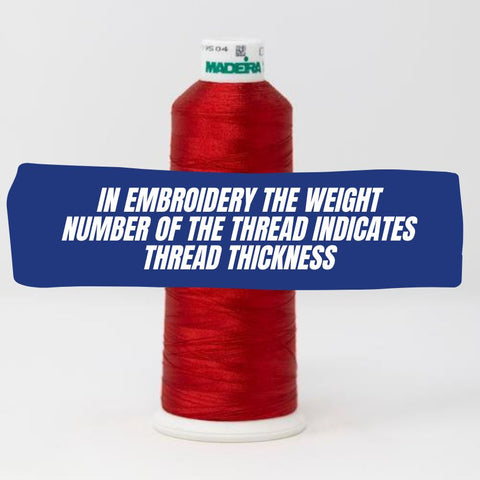Get help
Browse our collection of educational articles.

Embroidery Thread vs. Sewing Thread: What’s the Difference?
Many individuals who start out with embroidery end up developing an interest in sewing as well. For those of you who like to spread your wings and explore options beyond embroidery, it’s important to know what makes sewing thread different from embroidery thread and understand some of the similarities as well.

What is Embroidery Thread?
Embroidery thread is primarily designed for use in high-speed embroidery machines to add embellishments to almost any kind of fabric and is available in a huge range of vibrant colors to match any logo, color scheme, or decorative palette.
Embroidery machine owners often find and become loyal to a specific brand of thread that seems to work well with their machines and will run reliably with fewer thread breaks.
It's important to note that embroidery thread is not intended to be as strong as the thread used for garment construction and seams; its purpose is mainly decorative.
A special lubricant is applied allowing machine embroidery thread to be run at high speeds. Your basic polyester and rayon machine embroidery threads are manufactured using a continuous filament resulting in beautiful stitched-out designs.
What Is Sewing Thread?
Sewing threads are used for a versatile range of purposes encompassing three main functions: construction sewing, darning, and serging. Construction sewing is just what it sounds like; using the thread to stitch together various fabric pieces (creating seams), usually following a pattern to create a specific garment or fabric item. Darning is the practice of mending holes or repairing tears in clothing, restoring its integrity and prolonging its lifespan.
Serging (also called overlocking) refers to sewing seams, trimming allowances and finishing the raw edges of fabric so they don’t unravel with washing and wearing.
Serging requires a specialized serger or overlock machine along with a serger overlock thread that creates the kind of stitching required for these functions, and often complements construction sewing. While coming in a good variety of shades, the color range for sewing thread tends to be much smaller than for embroidery threads.
Different Fiber Types
Embroidery thread and sewing thread have some key differences. Embroidery thread is made from a wide range of fiber types, rayon, polyester, lyocell or nylon.
Because thread used for embroidery is mostly for decoration, you’ll notice it usually has a higher sheen compared to regular sewing thread, which isn’t meant to be the star of the show. The sheen is a result of a continuous filament construction versus a spun construction of sewing thread.
While sewing thread can be made of various materials, including silk (used in couture sewing), rayon, wool or nylon, cotton is the most common natural fiber, and polyester is the most common synthetic fiber that you’ll find on sewing thread spools.
100% cotton thread is often used in quilting, while general garment construction often employs cotton-wrapped polyester or polyester thread for superior strength. Nylon thread may be utilized for specialized applications like outdoor fabrics or edging patches.

Thread Weights in Embroidery and Sewing
In embroidery, the “weight number” of the thread indicates thread thickness, with smaller numbers representing thicker threads and larger numbers indicating thinner threads.
The standard weight most often used with machine embroidery thread is 40-weight, while thicker threads, like the much heavier 12-weight, are often used for decorative stitching and seams on heavier fabrics like denim pockets, upholstery, leather or bags.
Lighter 60-weight is thinner than 40 and is most helpful for embroidering small lettering and fine, intricate details. On the other hand, for general sewing purposes, 40-weight sewing thread is most commonly used, while quilters often opt for the slightly thinner 50-weight thread for piecing together quilt squares.
View this sewing collection for information on selecting the appropriate thread for specific applications, specialty threads, and machine needles.
Texture and Strength
Embroidery thread and sewing thread differ primarily in their texture and strength. Embroidery thread is specifically designed for decorative embellishment and is meant to create eye-catching, visually-appealing designs on garments and other fabric items like bags, leather boots, flags, banners, blankets, and linens, or anything a needle will go through.
It comes most often in glossy, shiny finishes as well as sparkly and rich metallic threads (although there are soft, lovely matte finish threads available also). In contrast, most sewing threads lack the showy characteristic sheen that is typically associated with embroidery thread and is meant primarily to hold seams together or secure raw fabric edges.
Comments
Leave a comment